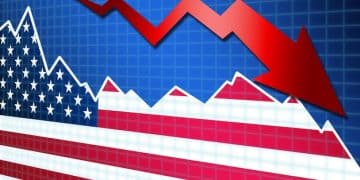Major Bank Revises US Economic Growth Forecast: Analysis & Impact

A major bank recently announced a revised economic growth forecast for the US, prompting significant discussion and analysis regarding its potential impact on various sectors.
The **major bank announces revised economic growth forecast for US**, signaling a shift in economic outlook that demands a closer examination of its implications. The updated projections can affect investment strategies, business planning, and overall market sentiment.
Understanding the Initial Economic Forecast
Before diving into the revised forecast, it’s crucial to understand the baseline from which these adjustments are made. Initial economic forecasts are formulated using a variety of factors, including macroeconomic indicators, historical data, and global economic trends.
These forecasts serve as crucial benchmarks for businesses, investors, and policymakers alike. They influence investment decisions, government spending, and monetary policy, shaping the economic landscape for the period ahead. Let’s briefly review what shapes these forecasts.
Key Factors Influencing Predictions
Several economic forces and indicators contribute to creating the initial outlook. Understanding these factors provides a framework for evaluating the revisions later on.
- GDP Growth: This is the broadest measure of economic activity, reflecting the total value of goods and services produced.
- Employment Figures: Changes in employment rates, job creation, and unemployment levels provide insights into consumer spending and business confidence.
- Inflation Rates: The rate at which the general level of prices for goods and services is rising, which affects purchasing power and interest rates.
- Interest Rates: Set by the Federal Reserve, these rates influence borrowing costs for businesses and consumers, impacting investment and spending.
These components, among others, are all critically analyzed to form an initial picture of economic growth.
In essence, the initial economic forecast is a critical tool, providing a baseline understanding of potential economic trajectories. Adjustments signal a change in the assessment of these underlying conditions.
Reasons Behind the Revised Economic Growth Forecast
When a major bank revises its economic growth forecast, it indicates a significant shift in economic perceptions driven by new data and evolving market conditions. These revisions are rarely arbitrary; they are based on a comprehensive reassessment of factors impacting the economy.
Understanding the driving reasons behind these revisions is key to understanding their implications. Let’s consider some of the factors most likely involved in the decision to revise the forecast.

Changes in Consumer Spending
Consumer spending is a major driver of the US economy, so fluctuations in this area can heavily influence growth forecasts. A decrease in consumer spending may indicate uncertainty. Changing purchasing habits may shift the forecast.
Geopolitical Factors
Unstable international relations and trade disputes can create ripple effects which impact economic activities. Considering geopolitical shifts is vital in these kinds of analyses.
The decision to revise an economic growth forecast is a complex process driven by a multitude of interconnected factors. By understanding these factors, stakeholders can better interpret changes in the economic outlook and make informed decisions.
Impact on Key Sectors of the Economy
Revised economic growth forecasts ripple through various sectors of the economy, creating both challenges and opportunities. Understanding these sector-specific impacts is crucial for investors, business owners, and policy makers.
Different industries react uniquely to the forecast, leading to a mosaic of diverse outcomes across the economic terrain. Here’s a look at some of the most significant sectors.
Technology Sector
The technology sector often thrives during periods of economic expansion, as innovation and investment accelerate. A revised forecast can trigger uncertainty, affecting tech stocks and venture capital investments.
Real Estate
Real estate can be particularly sensitive to shifts in economic growth. Lowered growth forecasts typically translate into lower housing demands and potential declines in property values. Changes in interest rates can affect this forecast directly.
- Construction: New building projects may slow down due to reduced investment and uncertain demand.
- Mortgage Rates: Reduced growth expectations can sometimes lead to lower interest rates to stimulate borrowing, impacting the housing market.
- Property Values: Slower economic growth can decrease demand for commercial and residential properties, affecting values.
Understanding such impacts allows stakeholders to anticipate changes and adapt strategies to navigate the evolving economic landscape.
Comparison With Other Forecasts
It’s important to consider them as a whole and in relation to one another. One forecast alone may not provide a complete or unbiased view.
By comparing multiple sources, a more insightful analysis can be achieved, fostering a more balanced perspective.

Analysis of Forecast Discrepancies
Discrepancies in different forecasts can arise from varied methodologies, data sources, and assumptions about future economic conditions. Examining these differences helps in understanding the potential range of economic outcomes and the factors driving them.
Expert Opinions on Diverging Forecasts
Economists and financial analysts often provide commentary on the reasons behind diverging forecasts. Their insights can reveal underlying economic trends and uncertainties that shape different perspectives.
Examining a wide range of expert opinions and forecasts enhances comprehensive understanding of the economic outlook, empowering stakeholders to make informed decisions amid uncertainty.
Implications for Investors and Consumers
A revised economic growth forecast directly affects investment strategies and consumer behavior. Investors adjust portfolios, consumers reevaluate spending habits, and businesses rethink expansion plans based on these revised projections.
In particular, investors and consumers need to understand how these adjustments impact different aspects of their financial lives. Let’s consider some key areas to focus on given the recent announcement.
Adapting Investment Strategies
Investors might consider diversifying their portfolios to mitigate risk, shifting towards more stable assets, or focusing on sectors that are less sensitive to economic downturns. A revised growth forecast often prompts a reconsideration of existing investment positions and future allocations.
Changes in Consumer Behavior
Consumers may reduce discretionary spending, increase savings, or delay major purchases in response to lowered growth projections. Understanding these behavioral shifts is vital for businesses planning their sales and marketing strategies.
Ultimately, understanding the implications of revised economic forecasts can empower both investors and consumers to make more informed decisions.
Future Outlook and Potential Scenarios
Economic forecasting involves inherent uncertainty, and revised growth forecasts are no exception. Evaluating potential future scenarios is vital for developing versatile strategies and preparing for various outcomes.
By acknowledging a range of possibilities, stakeholders can enhance risk management. Consider some possible future scenarios.
- Upside Scenario: If unforeseen positive developments occur (e.g., technological breakthroughs, policy changes), the economy could exceed revised growth expectations.
- Downside Scenario: Worsening global conditions or significant economic shocks could lead to growth falling below revised forecasts, resulting in a recession.
- Base Case Scenario: In this scenario, the economy performs roughly in line with the revised forecast, with minor fluctuations reflecting typical economic variability.
Businesses and investors should develop contingency plans for each scenario to ensure they are prepared to navigate different economic conditions.
Acknowledging the uncertainties inherent in economic forecasting and preparing for multiple scenarios is essential for stakeholders looking to navigate the ever-changing economic landscape.
| Key Point | Brief Description |
|---|---|
| 📉 Revised Forecast | Bank lowered US economic growth expectations. |
| 💰 Sector Impacts | Tech and Real Estate will probably experience adjustments. |
| 💡 Investor Strategies | Diversify portfolios and watch rate-sensitive holdings. |
| 🤔 Future Scenarios | Plan for upside, downside, and base case economic paths. |
FAQ
▼
The revision can be attributed to several factors, including changes in consumer spending, geopolitical issues, and shifts in key economic indicators such as employment and inflation.
▼
A revised forecast creates increased uncertainty, which could lead to fluctuations in tech market stocks and a slowdown in venture capital investments, given its reliance on growth prospects.
▼
Investors may opt to shift to more stable assets, diversify their investment portfolios, or focus on sectors with less sensitivity to economic downturns to mitigate risks in changing times.
▼
Consumers could reduce how much they spend on non-essential items, save more to prepare for hardship, or wait longer before buying something expensive to prepare for potential changes.
▼
Potential economic scenarios include an upside scenario with unforeseen positive developments, a downside scenario leading to recession, and a base case scenario aligning with the forecast.
Conclusion
The **major bank announces revised economic growth forecast for US** presents a pivotal moment for economic stakeholders. They can adapt and make well-informed decisions by acknowledging underlying reasons, probable sector effects, and possible future scenarios. Understanding these changes will empower informed responses to the ever-evolving economic situation.





